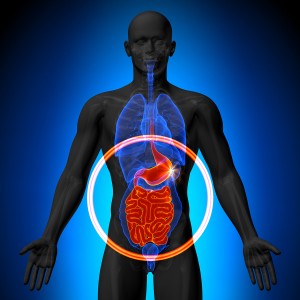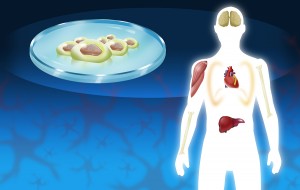There is a lot of talk about the gut and brain connection. At the 23rd Annual World Congress on Anti-Aging Medicine (Dec. 11-13, 2015) in Las Vegas there were several lectures pointing out the importance of the gut flora for proper brain function. As a matter of fact, if you have the wrong gut flora, you can get a number of diseases like diabetes, fibromyalgia, rheumatoid arthritis, multiple sclerosis, muscular dystrophy, some cancers and even obesity. Martin P. Gallagher, MD, DC talked about this in his talk entitled “Gut on Fire, Brain on Fire!”
Function of the microbiome
The microbiome is the sum of all microbial organisms inhabiting the human body, which colonize mainly the colon, but also to a lesser degree the small intestine. Dr. Gallagher stated that the microbiome weighs only 7.1 oz., although in the past some have estimated its weight to be as high as 3 pounds. The purpose of the microbiome is to help form a gut/blood barrier. It forms a 30-micron thick layer in the GI tract, protects the intestinal lining and metabolizes food remnants, especially from carbohydrates. In addition, it also communicates with the immune system. There is a cross talk between the lining of the gut and the and the body’s immune system. The gut bacteria help the body to create stability; as a result the good bacteria also decrease intestinal permeability.
Leaky gut syndrome develops
When inflammation occurs in the gut, the thickness of the biofilm is less than 30 microns. Intestinal permeability increases and becomes “leaky gut syndrome”. This can be the cause of autoimmune diseases and possibly other diseases.
The enteric nervous system
The gut can produce as many neurotransmitters as the brain and spinal cord can synthesize. The enteric nervous system communicates with the brain through the vagal nerve. Serotonin is an important neurotransmitter that regulates motility of the gut. The control system of the gut can work on its own and override the concerns of the central nervous system.
Parkinson’s disease is a disorder of the enteric nervous system as well as the brain. With Alzheimer’s disease the characteristic brain lesions are also present in the enteric nervous system!
A mouse experiment showed the following. The Lactobacillus strain is normally part of the microbiome of the gut. Re-introduction of Lactobacillus into the gut flora resulted in healing certain parts of the brains of these animals, which researchers associate with anxiety and depression. But when the researchers severed the vagal nerve of these animals, none of these healing changes occurred.
The gut-brain-axis
For this reason the researchers suggested that the gut bacteria are able to communicate with the brain via the vagal nerve. Researchers have coined this connection the “gut-brain axis”. These protective gut bacteria have the ability to protect humans from gastric acidity, from bile acid toxicity, they adhere to the lining of the gut and they persist to reside within the gastrointestinal tract. Probiotics help the immune system to maintain the immunologic memory and to secrete antibodies, called immunoglobulins.
Two strains with benefit to humans are Lactobacillus rhamnosus GG and Saccharomyces boulardii. Probiotics often help against diarrhea. The natural food for gut bacteria in the colon comes from starches of chicory, asparagus, inulin and onions that are indigestible in the stomach and small intestine, but are fermented in the colon to provide food for the bacteria residing there.
Small Intestinal Bacterial Overgrowth (SIBO)
Overgrowth of the small intestine with bacteria that produce endotoxins appears to have significance in both animal models and human disease. Chlamydia species as well as Borrelia burgdorferi (Lyme) can produce toxins that cause hypersensitivity to pain in soft tissues in fibromyalgia and animal models of fibromyalgia. Moreover, SIBO – small intestinal bacterial overgrowth – in experimental animals caused the same hypersensitivity of the soft tissues and also leaky gut syndrome.
Risk factors for SIBO
What causes SIBO is too little stomach acid production, treatment with proton pump inhibitors (powerful anti acid medications) and antibiotics. To summarize, Dr.Gallagher said that SIBO also occurs in post-surgical patients, in patients with diabetes, is brought on by alcohol, nicotine, drugs and GMO foods.
Neurogenic inflammation
Normally the blood brain barrier keeps immune cells from the body out of the brain. Only glucose, proteins and lipids are allowed into the brain, but not lipophilic neurotoxins. In contrast, neurogenic triggers, when admitted to the brain, will compromise the function of the immune cells of the CNS, called microglia. In essence, this can result in memory loss, Alzheimer’s, dementia, seizures, migraines, Parkinson’s Disease, multiple sclerosis, cancer, weakness, numbness, etc.
What triggers inflammation?
Here is a long list of different items that cause inflammation: aging, hormone deficiencies, obesity, diabetes mellitus, cardiovascular disease, fungal infection, the Standard American diet (SAD), pain, trauma and mechanical stress, heavy metals, food allergies, toxins, gut dysbiosis, small intestinal bacterial overgrowth, mal-digestion/absorption, prescription drugs, over-the-counter drugs, recreational drugs and alcohol, lack of exercise and lack of sleep.
Neurotoxic insults start the chain of reactions like heavy metals, nutritional deficiencies, viruses/fungus/bacteria, inflammatory diet, MSG, solvents, pesticides, herbicides, etc.. One or more of these factors destabilize the tight junctions of the blood brain barrier, which leads to neurogenic inflammation.
Result of neurogenic inflammation
The result is Parkinson’s disease, MS, dementia, chronic pain, behavioral and personality changes, Alzheimer’s disease, ALS and Lyme disease. What seems to be happening a lot is that there is overgrowth of abnormal bacteria in the small bowel, which produce toxins. These in turn lead to leaky gut syndrome, which allows neurogenic triggers to attack the blood brain barrier. It seems like from here it is a short step to neurotoxic insults of the brain overstimulating the microglia, which will produce the diseases listed above.
Healing of brain inflammation
First of all, treatment starts with the Mediterranean diet, which has been shown to have anti-inflammatory properties. Second, people who are gluten sensitive need to eliminate gluten entirely from their food. Third, casein sensitive people need to eliminate dairy products. Furthermore, a triple strength, molecularly distilled fish oil product is taken as a supplement every day with 4 grams or more of DHA/EPA. This helps the anti-inflammatory response.
Glutathione
One of the most powerful antioxidants and anti-inflammatories is intravenous glutathione. This is given as intravenous chelation therapy, which removes heavy metals. Other chelation agents such as EDTA intravenously may be given alternatively. Dr.Gallagher said that glutathione serves as primary cellular defense against free radicals, is a powerful antioxidant and serves as detoxifying agent against xenobiotics. Xenobiotics are remnants of artificial fertilizers, pesticides and pollutants that are contained in crops we eat.
Dr. Gallagher gives 600mg of glutathione twice per day intravenously for 30 days. Uniquely, in Parkinson’s disease patients whose mid brain is often poisoned by mercury this leads to 42% decline of disabilities and the effect lasts for 2 to 4 months after this treatment has been stopped. Coupled with this the treatment also protects telomeres, the caps on the ends of cellular DNA as well as mitochondrial DNA. In addition, glutathione is protective of neurons and nerves.
Curcumin
This common Indian spice, found in turmeric is a potent anti-inflammatory. It is a safe natural agent and has also anti-viral and anti-tumor activities. It binds to the vitamin D receptor and works synergistically together with vitamin D3. Solid lipid curcumin particle technology makes curcumin 65-fold more bioavailable; free curcumin is allowed to pass the blood brain barrier. Lower doses achieve the same effect than regular curcumin.
According to a publication using lipidated curcumin the following observations were made: improved vascular function; equally important, inflammatory markers reduced by 14%; in like manner, triglycerides lowered by 14%; by the same token, oxidative stress reduced; not to mention, catalase increased and finally total antioxidant status improved. Here is another paper about lipidated curcumin.
Omega-3 fatty acids
Omega-3 fatty acids are anti-inflammatory by countering the arachidonic acid pathway that leads to inflammation. Physicians recommend it as triple strength, molecularly distilled fish oil. DHA/EPA are the active ingredients. Chronic inflammation requires 2 to 12 grams daily; irritable bowel syndrome 6 to 12 grams daily; depression, anxiety and insomnia require 2 to 4 grams per day; autoimmune disease, back pain and degenerative joint disease 4 to 12 grams per day.
Gut/brain dysbiosis
For gut/brain dysbiosis Dr. Gallagher recommended to start with a 10-day fruit/vegetable detox program. Milk thistle, glutathione and pancreatic enzymes in combination lead to improvement. Lipidated curcumin is also useful. The physician also gives glutamine, prebiotics and probiotics for gut support. He also tells the patient to take molecularly distilled fish oil (DHA/EPA) and vitamin D3 as anti-inflammatories. Doctors also administer oral and intravenous glutathione to detoxify. Many doctors use natural as a combination of glutathione, oregano, olive leaf and silver salts.
Conclusion
Inflammation can start in the gut, lead to leaky gut syndrome and break down the blood/brain barrier. The end result is that inflammation develops in the brain and Alzheimer’s disease and dementia can occur. The sooner the physician starts with treatment, the faster the recovery is. When the patient has reached the end stage, it is difficult to turn the inflammatory process around. Fortunately there are effective ways to get the inflammation under control with intravenous glutathione in the beginning and subsequent treatment with lipidated curcumin, omega-3 fatty acid and vitamin D3. A permanent switch to a Mediterranean diet is important as well to keep inflammation under control.
Lifestyle and nutrition choices are important for prevention
A few years back this mainstream medicine considered this type of approach as “quackery”; now it is the latest information from research into the brain/gut connection. The right lifestyle and nutrition choices can do a lot on a preventative basis. Once disease has taken root, treatment may still be possible, but once it is at a later stage a full cure is unlikely.















